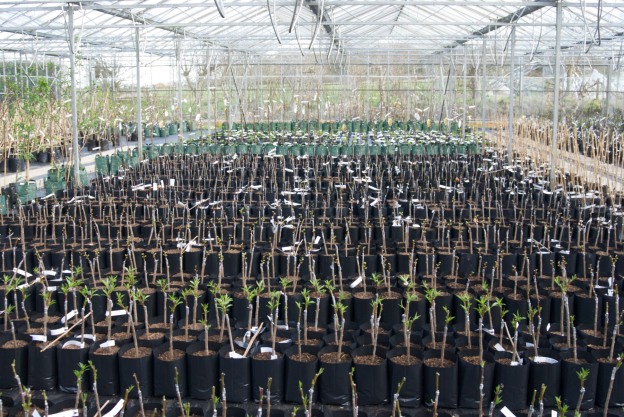A small sample of our last 11 weeks work ,such a relief when those green shoots open properly.
Monthly Archives: March 2011
A Fig Tree for every garden.
Ancient fig trees are majestic things, wild snaking branches head off in all directions, dropping down to add more roots then racing off again. Young fig trees are just as impressive in the crop they can (and should) give you. The tree below is 7 years since planting and will average 30-40 fruit, not a huge quantity, but the quality, is the thing.
The total height and spread is around 6 ft (2m) and this picture is taken in early summer, just before it was pruned to let the sun get at the figs.As you can see it is in the open with only a hedge 40 ft away for protection. The roots are not restricted as the soil conditions are solid, brick making clay !
The real trick in getting figs to ripen in the UK is pruning, feeding and watering (is that 3 tricks ?). I am constantly answering the question; “my fig tree has loads of fruit and they all drop off”, with another question; “do you ever feed or water it ?” -the answer is always “no”. Fig trees in the wild will grow in the most appalling conditions, in rocks, on the sides of mountains, but they are designed to do this with huge root systems to seek out food and water. In a garden environment more care is needed if you wish to savour the rewards and have a tree that is only 8ft tall.
Plant your tree carefully, as you would any other, with the exception that it likes to be 2″ deeper than it was in the pot when planted. In clay soil give it a good 3ft square hole to live in with good free draining loam to put roots into. In good fertile garden soil some root restriction will be needed, use paving slabs as walls, packing them tight together and leave 2-3 ” of slab above the soil to stop the roots walking out, pack the base with broken bricks and fill with your fertile, loamy soil.
The tree shown above had rooted into the top of the brick wall and grown over the greenhouse on the far side, to root yet again, continuing on into the kitchen garden beyond. A case for some selective pruning.
Fig trees in the UK will only produce one crop per year in a garden, those fruit that succeed are the embryo figs on the tips of last summers growth. None of the small figs you see at leaf fall are going to develop into the luscious syrupy things you are looking for. At the end of Autumn it is best to remove any fruit bigger then a small pea by shaking the branches.
Pruning is the best aid to getting a crop to ripen properly. You need to create a framework of short branches not unlike spurs on which the fruit can ripen. Sunshine is needed in the middle of the tree to ripen the growing wood and fruit, fig trees have a canopy of huge leaves which will shade out everything.
In the first 2-3 years from planting you need to establish the tree shape as an open goblet or fan, creating a scaffold of branches quite low to the ground. Following on from this you need to start the year with some tip pruning, remove only the outermost growing point leaving behind it the hidden embryo leaf and fruit buds. as the buds grow in spring allow the branch to produce 4- 5 leaves, this can be more or less depending on the speed of growth, then pinch the tip out again. This will stop the fig producing extension growth for a short while, most years this can be done up to twice before the tree stops growing in August. This sounds too simple but in practice it is best kept that way.
Feeding is easiest if done as a combined mulch in early spring,this will keep moisture in at the same time. Be prepared to add some chicken manure if needed or even a liquid feed in the early years and definitely always foliar feed with seaweed every 2-3 weeks, with figs this makes a huge difference, increasing the leaf size by up to 50% – which means bigger, better and juicier Figs.
Water is essential to growing figs , keep it plentiful from May through early summer.Regular weekly drowning is better that a dribble. Figs contain a large amount of water when ripe, high levels of potassium and fibre too.Insufficient water will lead to dry,wooly fruits that most likely will drop prematurely.





